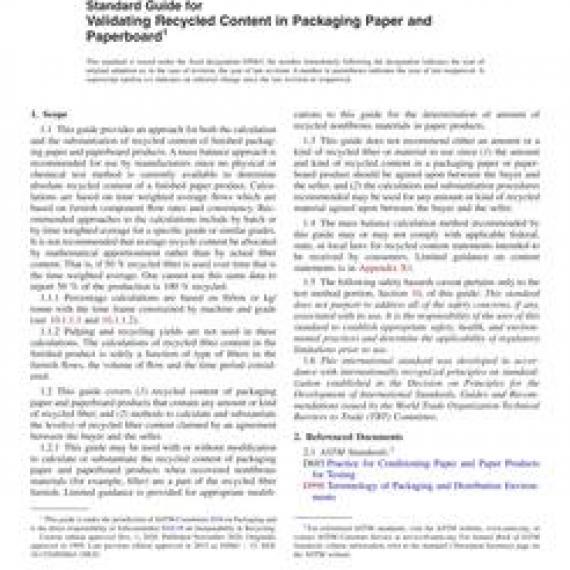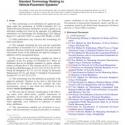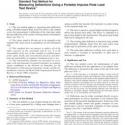No products
ASTM D5663-15(2020)
ASTM D5663-15(2020) Standard Guide for Validating Recycled Content in Packaging Paper and Paperboard
standard by ASTM International, 11/01/2020
Full Description
1.1''This guide provides an approach for both the calculation and the substantiation of recycled content of finished packaging paper and paperboard products. A mass balance approach is recommended for use by manufacturers since no physical or chemical test method is currently available to determine absolute recycled content of a finished paper product. Calculations are based on time weighted average flows which are based on furnish component flow rates and consistency. Recommended approaches to the calculations include by batch or by time weighted average for a specific grade or similar grades. It is not recommended that average recycle content be allocated by mathematical apportionment rather than by actual fiber content. That is, if 50 % recycled fiber is used over time that is the time weighted average. One cannot use this same data to report 50 % of the production is 100 % recycled.
1.1.1''Percentage calculations are based on lb/ton or kg/tonne with the time frame constrained by machine and grade (see 10.1.1.1 and 10.1.1.2).
1.1.2''Pulping and recycling yields are not used in these calculations. The calculations of recycled fiber content in the finished product is solely a function of type of fibers in the furnish flows, the volume of flow and the time period considered.
1.2''This guide covers (1) recycled content of packaging paper and paperboard products that contain any amount or kind of recycled fiber; and (2) methods to calculate and substantiate the level(s) of recycled fiber content claimed by an agreement between the buyer and the seller.
1.2.1''This guide may be used with or without modification to calculate or substantiate the recycled content of packaging paper and paperboard products when recovered nonfibrous materials (for example, filler) are a part of the recycled fiber furnish. Limited guidance is provided for appropriate modifications to this guide for the determination of amount of recycled nonfibrous materials in paper products.
1.3''This guide does not recommend either an amount or a kind of recycled fiber or material to use since (1) the amount and kind of recycled content in a packaging paper or paperboard product should be agreed upon between the buyer and the seller, and (2) the calculation and substantiation procedures recommended may be used for any amount or kind of recycled material agreed upon between the buyer and the seller.
1.4''The mass balance calculation method recommended by this guide may or may not comply with applicable federal, state, or local laws for recycled content statements intended to be received by consumers. Limited guidance on content statements is in Appendix X1.
1.5''The following safety hazards caveat pertains only to the test method portion, Section 10, of this guide: This standard does not purport to address all of the safety concerns, if any, associated with its use. It is the responsibility of the user of this standard to establish appropriate safety, health, and environmental practices and determine the applicability of regulatory limitations prior to use.
1.6''This international standard was developed in accordance with internationally recognized principles on standardization established in the Decision on Principles for the Development of International Standards, Guides and Recommendations issued by the World Trade Organization Technical Barriers to Trade (TBT) Committee.


































